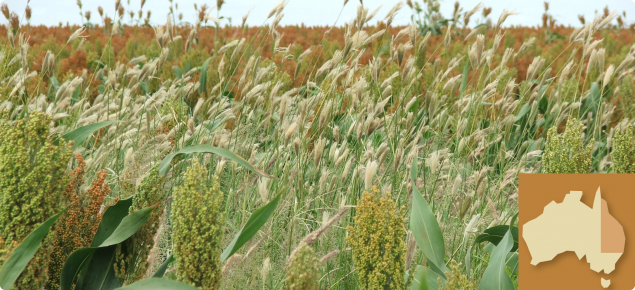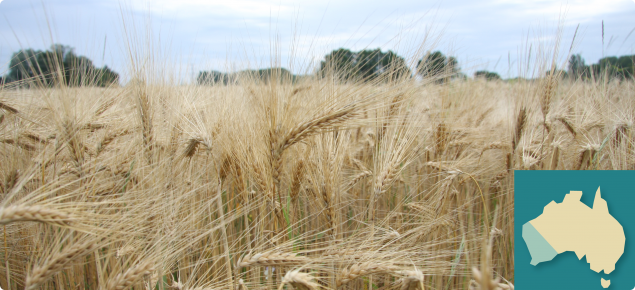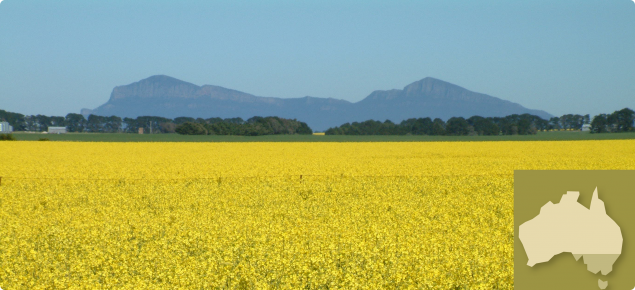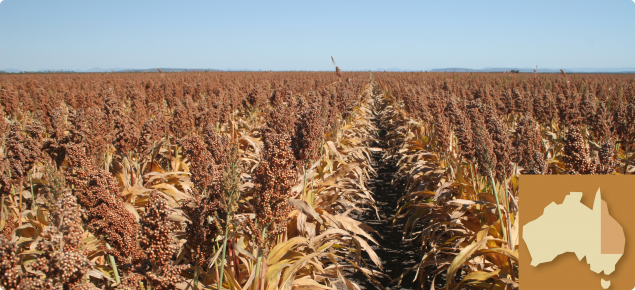Download the Weed Seed Wizard to look at scenarios from around Australia or make your own.
Input
The Wizard uses farm-specific information.
- The users input their paddock soil type, their local weather and the weed species specific to their farm into the first of the input windows (setup scenario window). As the model simulates the dormancy and germinability of each weed species against soil moisture and temperature, major inputs that influence the predictions include weather characteristics such as rainfall, daily temperature and evaporation plus soil type (which provides information on soil water-holding capacity).
- The Wizard comes with a set of weather files (in CSV format) for each state. The user can choose the file for the site closest to their farm or set up their own from their weather stations or from weather providers.
- There is also a range of soil types (sand to clay) and a choice of weed species.
- The choice of weed species is listed below
| Afghan melon (Citrullus amarus) |
| Annual ryegrass (Lolium rigidum) |
| Barley grass (Hordeum leporinum) |
| Barnyard grass (Echinochloa colona) |
| Bell vine (Ipomoea plebeian) |
| Bladder ketmia (Hibiscus trionum) |
| Brome grass (Bromus spp.) |
| Button grass (Dactyloctenium radulans) |
| Caltrop (Tribulus terrestris) |
| Cow vine (Ipomoea lonchophylla) |
| Doublegee (Rumex hypogaeus) |
| Feathertop Rhodes grass (Chloris virgata) |
| Liverseed grass (Urochloa panicoides) |
| Fleabane (Conyza bonariensis) |
| Marshmallow (Malva parviflora) |
| Maticaria (Oncosiphon spp.) |
| Paradoxa grass (Phalaris paradoxa) |
| Roly Poly (Salsola australis) |
| Silver grass (Vulpia spp.) |
| Sowthistle (Sonchus oleraceus) |
| Stinking lovegrass (Eragrostis cilianensis) |
| Sweet summer grass (Brachiaria eruciformis) |
| Wild oat (Avena fatua) |
| Wild radish (Raphanus raphanistrum) |
| Windmill grass (Chloris truncata) |
| Wireweed (Polygonum aviculare) |
- The users then put in their past management records or future plans into the second input window (event management window). This window shows a sequence of management events for a specific paddock, where each event is expressed as a date and a description of the event. The choice of events is very flexible to reflect the multitude of options growers have and how they can they integrate them into their crop management (Table 1).
| Event type | Choices |
|---|---|
| Till event | Autumn tickle, finger harrow, full inversion, Kelly chain, off-set disc, one-way disc, rotary harrow, rotary hoe, scarify to 5cm or new tillage type |
| Sow event | Type of crop, seeding rate, percentage viable seed, seeding implement |
| Spray event | Specific or new herbicide, control percentage for each species, residual control percentage and half-life |
| Harvest event | Numerous harvest seed management options (normal, baling windrows, chaff cart, crop-topping, cut for hay, cut for silage, desiccation, green manure, narrow windrow and burn, seed destructor, swathing and new), choice of percentage of weed and crop seeds dropped, plants killed and yield reduction |
| Volunteer pasture event | Percentage of seeds dropped after a year of volunteer pasture |
| Graze event | Number of plants killed and percentage of seeds dropped after stock grazing |
| Irrigation event | Choice to wet soil to field capacity or with a specified number of millilitres |
| Plant count event | Weed and crop counts |
| Advanced events | Seed rain (percentage of seeds produced this season relative to the average season), incorporation event (ability to adjust for stock trampling seed into soil), seed count and seed reset (can reset weed seed numbers at any time, for example, biosecurity event) |
Output
After the scenario has been simulated, there are three main sets of results (or outputs) to be viewed from the simulation window; the seedbank, plant numbers, and crop yields. These outputs show how the management decisions affect the weed seedbank numbers, the weed germination and density and ultimately, the crop yield.
- Each weed species has different dormancy and germination characteristics:
- Some species have no dormancy, others have an after-ripening requirement but can germinate with the opening rains while others require specific environmental (light, temperature, etc) cues for dormancy to be broken and germination to commence. Different management techniques, for example a tillage operation, can redistribute the seed and place it into an environment which is more (or less) conducive to germination and emergence. The Wizard portrays the number of seeds in the seedbank over time, where numbers increase each year with seed production and seedbank replenishment then decline due to germination and seed decay.
- The simulated plant numbers are shown to increase with every germination (following a breakdown in dormancy and an adequate rainfall event) and to decrease with each control event (for example a herbicide application or tillage event) until the plants are removed at harvest. By exploring a range of simulated scenarios, the user can easily see how weed and seed numbers can be affected, potentially over several seasons, by the choice of management strategy and the herbicide resistance status of each species.
- The Wizard also estimates how much crop yield is reduced by weed competition, based on a hyperbolic competition function and provides a comparison with the potential harvest yield without weeds. The user can then calculate the income of the scenario and compare the income generated by weed-free and weed-reduced yields. This is an important tool for growers as they can easily see how weeds can affect crop yields and ultimately profitability by quickly assessing the disparity between the potential and modelled yields.





